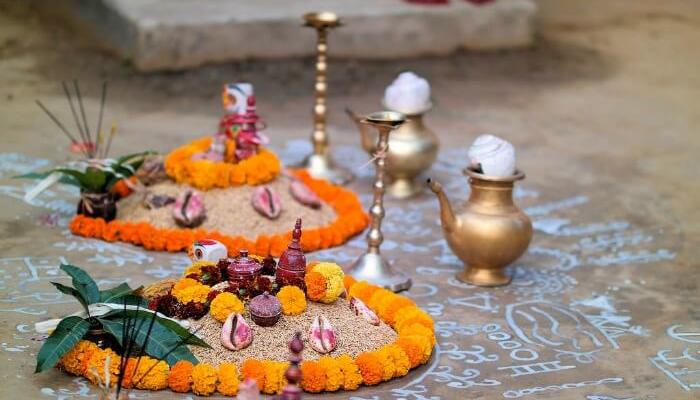New Crop Pic Source: Wikipedia
The traditional cuisine of India is as distinct as its culture and people. Rice is the stand out element in this cuisine. In India rice provides daily sustenance for more than 60% of the population. No other crop has been developed to such an extent, to fit hundreds of ecological niches all over the country, from the temperate high hills of the Himalayas to tropical lowland deep water and salt-water marshes of the seacoasts.
A strong rice culture holds over a vast part of India. The Indus civilization recognized rice cultivation as the basis of social order with strong moral and religious overtones. Rice is an integral part of social rites, rituals and festivals in India. So the whole society, it’s culture and identity is linked to the rice-systems.
Thanksgiving Festivals and Tasting New Rice
Majority of Indian festivals are tied to agricultural cycles. Every major stage in the traditional rice cycle has become focus of the ritual attention.
Rice harvest time is occasion of festivity in India. It is celebrated by different names in various states of India such as Paus Utsav in Bengal, Dhanu Sankranti in Orissa, Pongal in Tamilnadu, Huttari in Karnataka, Makar Sankaranti in Andhra Pradesh, Onam in Kerala etc.

| In most of the states, it coincides with New Year. The use of newly harvested rice is carefully regulated. In most states, harvest festivals include rice offering to God while in some tribes eating of new rice is a separate ceremony. |

| In India rice is often directly associated with prosperity and fertility. The first feed to an infand known as ‘Annaprashan’ makes a child’s first eating of solid food. Even in marriages, rice is used to bless the couple for a life of happiness, health and prosperity. |
Traditional Rice Seed Diversity
Half a century ago, India was home to more than 100,000 rice varieties with a wide range of diversity in taste/aroma and nutrition etc.
Today, much of this biodiversity is lost, forced out by the quest for high-yield hybrids and varieties. It is said that now we are left with only about 7000 varieties of rice and numbers continue to dwindle.

| The Koraput region in the state of Odisha in India’s east was historically among the world’s leading areas of rice diversification. In the 1950s, an official survey found farmers here growing more than 1,700 different rice varieties. Now, more than 1,400 farmers in the region are at the heart of a movement to safeguard what remains of this genetic wealth. Heirloom varieties, adapted over centuries to local ecologies, also proved hardier in the face of problems such as pests and drough. |
Some farmers of India – the traditional plant breeders- have developed immense varieties in rice through selection processes. We have lost many of the local specific varieties in the process of agriculture transformation to mass production.
The major GI Protected varieties of India are as follows Jeeraphool (Chhattisgarh), Katarni (Bihar), Tulaipanji and Gobindabhog (West Bengal), Joha (Assam), Ambemohar and Ajara Ghansal (Maharashtra), Basmati (Punjab, Haryana, Himachal Pradesh, Delhi, Uttarkhand, Uttar Pradesh, Jammu and Kashmir), Kalanamak (Uttar Pradesh) Kaipad, Wayanad Jeerakasala, Wayand Gandhakasala, Palakkadan Matta, Pokkali, and Navara (all from Kerala).
Owing to their medicinal properties, many of the Indian rice varieties have been traditionally used in Ayurvada by the traditional healer for generations. Rice has been recognized in the Vedic period for its medicinal properties too. The uses of rice in traditional medicine is closely interwoven with its as a food item.
We need to explore the chances of sustaining rice and rice-culture.
Traditional rice varieties taste best when it is cooked in traditional cookware like bamboo steamer. Check out our traditional cookware collection HERE.


